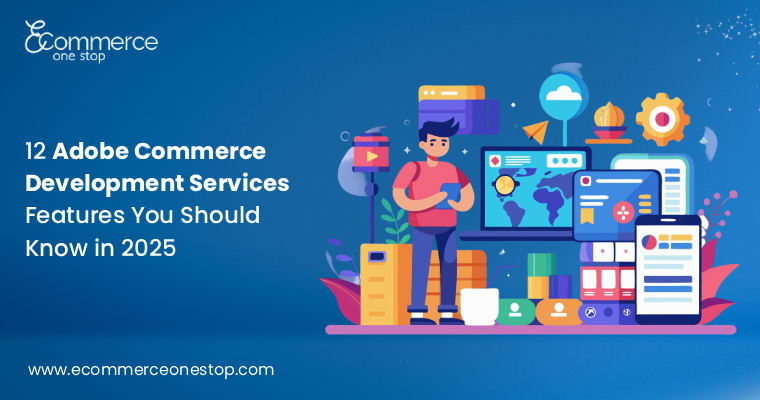Global e-commerce sales are projected to hit
$6.8 trillion by 2028 (
Forrester, 2024). That's a huge number, right? It shows how online shopping keeps growing, and businesses need strong platforms to handle it.
If you're looking into adobe commerce development services, you're in the right place. An
adobe commerce development company can help build stores that stand out.
Let's talk about what makes Adobe Commerce special this year. It's all about features that help stores run smoothly and keep customers coming back. We'll walk you through 12 key ones. Each one solves real problems for online sellers.
Get Your Project Started
Book a free consultation with our Ecommerce experts.
Connect Now

What Are The 12 Adobe Commerce Development Services Features You Should Know in 2025?
1. Headless Commerce
Headless commerce separates the front end from the back end, letting you use one backend for multiple frontends, such as apps or websites. This setup gives more flexibility in design and updates without changing the core system.
- Makes updates faster and easier.
- Improves loading times for users.
- Allows adding new channels like social media shops.
2. Progressive Web Apps (PWA)
PWAs combine web and app features. Adobe Commerce's PWA Studio simplifies setup. Users get app-like speed on their phones, and sometimes offline access
- Speeds up shopping and reduces bounce rates.
- Helps small stores compete with bigger ones.
- Improves mobile shopping experience.
3. Omnichannel Retailing
Omnichannel provides a consistent experience across all channels, including website, app, and in-store. Adobe Commerce keeps carts, orders, and inventory synced everywhere.
- Tracks orders from any device.
- Syncs inventory in real time.
- Supports growing brands with consistent experience.
4. Real-Time Personalization
Real-time personalization suggests products based on what a user does at that moment. Adobe Commerce uses data from customer history to make accurate recommendations.
- Makes shopping feel personal.
- Boosts purchases by showing relevant items.
- Helps businesses stay competitive with customer-focused experiences.
5. AI Integration
AI automates tasks in Adobe Commerce. It predicts customer needs, sets prices dynamically, and supports chatbots for customer questions.
- Spots trends early.
- Reduces errors in orders.
- Saves time and improves workflows.
6. Conversational Commerce
Conversational commerce lets customers shop through chat. Adobe tools allow asking questions and making purchases in one place.
- Provides faster support for customers
- Builds trust with instant responses.
- Easy to add for Adobe Commerce developers.
7. Product Information Management (PIM)
PIM keeps product catalogs organized. Adobe integrates with tools like Akeneo to handle large inventories efficiently.
- Prevents messy product data.
- Makes catalog updates easier.
- Improves sales with accurate information.
8. Multi-Vendor Marketplace Setup
This lets multiple vendors sell on your site. Adobe extensions make management simple while taking a commission from each sale.
- Opens new revenue channels.
- Easy vendor management.
- Customizable for different business needs.
9. Visual and Voice Search
Visual search lets users find products using images, while voice search works with assistants like Siri. Adobe supports these through add-ons.
- Matches modern shopping habits.
- Increases traffic from younger users.
- Improves search convenience.
10. Subscription Commerce
Subscriptions allow customers to get repeat orders automatically. Adobe partners with tools like Zuora for setup.
- Provides steady supply for customers.
- Generates consistent revenue.
- Works well for products like beauty and health items.
11. Buy Now, Pay Later (BNPL)
BNPL allows users to split payments over time. Adobe connects with providers like Affirm.
- Reduces barriers to purchase.
- Encourages more sales.
- Popular among younger shoppers.
12. Multi-Store and Multi-Currency Handling
This feature lets you manage multiple stores and currencies from one backend. Adobe guides make setup straightforward.
- Supports global brands.
- Simplifies currency management.
- Prepares businesses for expanding e-commerce markets.
Conclusion
In conclusion,
picking the right adobe commerce development services matters a lot in 2025. With these 12 features, your store can thrive. As an expert in this area, I see how they make a difference every day.
In 2025,
44.2% of e-commerce sales in the USA come from mobile devices. (
Exploding Topics).
Ready to get started? Connect with our team at our adobe commerce development company for help with your project. We'll guide you through it all.
Looking for the Best Adobe Commerce Development Company in USA?
Let's Talk

FAQs
1. What is the average cost of Adobe Commerce development services in 2025?
Costs range from $50,000 to $200,000, depending on store size and custom needs. Factors like integrations add to the price.
2. How long does it take to develop an Adobe Commerce store?
It usually takes 3 to 6 months. Simple sites finish faster, while complex ones with custom features need more time.
3. Is Adobe Commerce better for B2B or B2C?
It's strong for both, but shines in B2B with tools for quotes and accounts. B2C gets great personalization options.
4. Can a magento development company handle Adobe Commerce upgrades?
Yes, most can. They know the shift from Magento to Adobe and help with smooth updates.
5. What support do adobe commerce development companies offer after launch?
They provide ongoing maintenance, security patches, and performance checks to keep your store running well.




